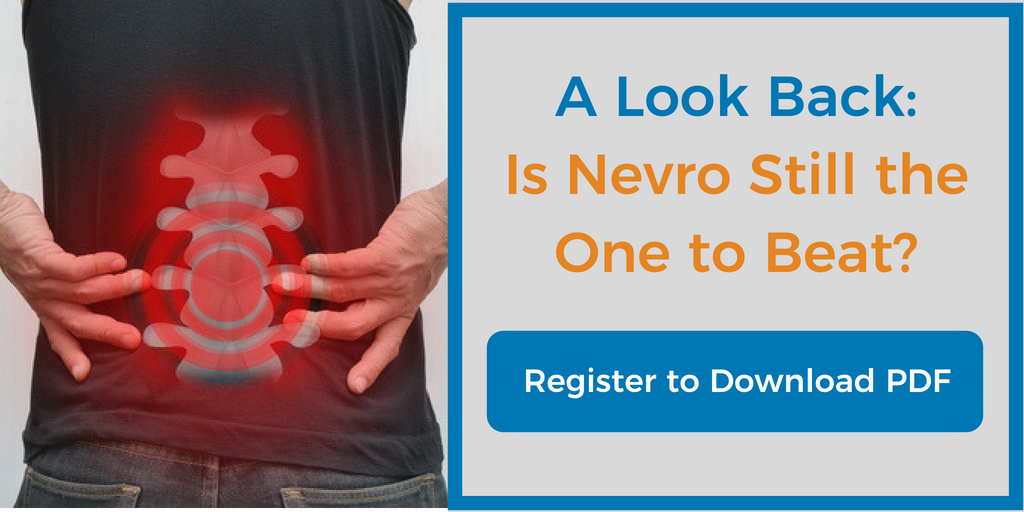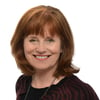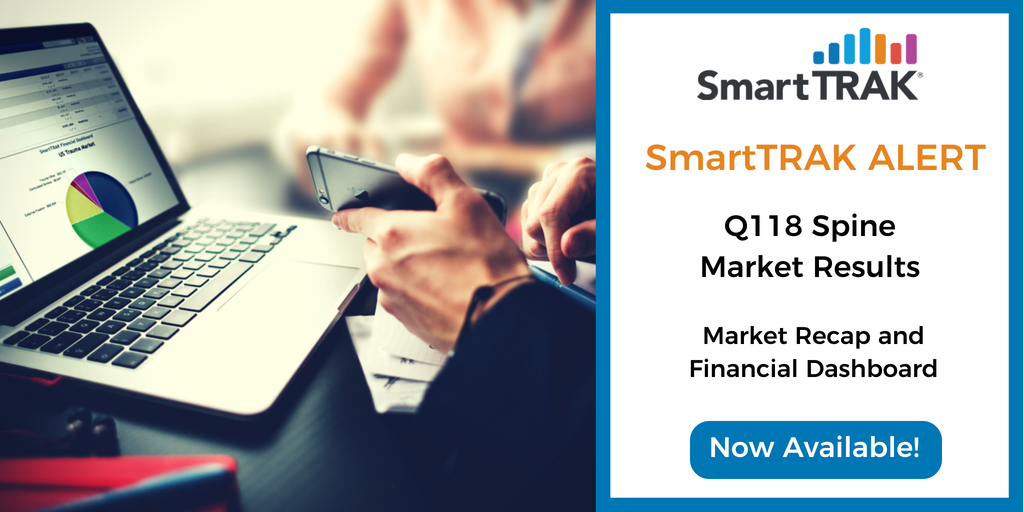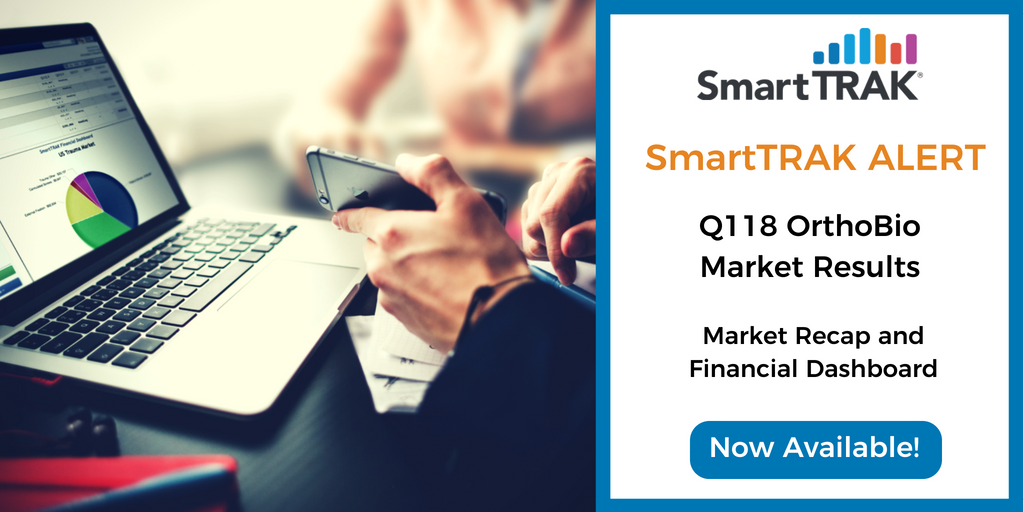In May 2017, Nevro CEO Rami Elghandour chatted with Anne Staylor, BioMedGPS Managing Editor/Neuro Analyst to discuss dynamics in 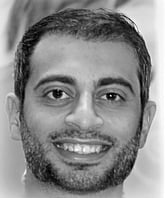 the global spinal cord stimulation (SCS) market, including trends, drivers, challenges, competition, and opportunity that would influence the Company’s growth.
the global spinal cord stimulation (SCS) market, including trends, drivers, challenges, competition, and opportunity that would influence the Company’s growth.
A fascinating read then, that now has us appraising a year later if Elghandour's expansion predictions came to pass. Is Nevro still the one to beat as the top leader in the neuromodulation field?
 or read the interview in full below!
or read the interview in full below!
By Anne Staylor, Managing Editor, SmartTRAK Neuromodulation Update 9:12AM PT, May 25, 2017
In an interview with BioMedGPS, Nevro CEO Rami Elghandour discussed the Company’s success, its growth strategies, and some of the challenges of being the one to beat in the spinal cord stimulation (SCS) market.
Now, as other companies bring next gen devices to market, competition has intensified, and Nevro has become the company and technology to beat in spinal cord stimulation.
To find out more about Nevro’s growth strategies, the competitive landscape, and what’s next for the Company, BioMedGPS interviewed Nevro CEO Rami Elghandour via Skype from his office in Redwood City, California.
Nevro had another extremely successful year in 2016. Revenues were up 228% over the prior year, you received FDA approval for the Surpass surgical (aka paddle) lead, raised $172.5 million in public offering of convertible senior notes, and published SENZA-RCT 24-month data in Neurosurgery.
Looking ahead, what are your biggest priorities in 2017?
Rami Elghandour: We have two main priorities. The first priority is to continue to execute commercially both in the US and internationally to expand access to HF10 therapy to the many more patients who are in need. Simultaneously, we have the same sense of urgency around our clinical pipeline as we do around our everyday business, and in that regard one of our biggest priorities is to continue to advance our pipeline and invest in new indications and technological advancements that hopefully over time will continue to more broadly expand the potential for HF10 therapy to be a tool for physicians to help a larger number of patients.
Nevro has been growing very quickly and expanding the spinal cord stimulator market, particularly in difficult to treat low back pain patients. How many patients have been treated with HF10 therapy to date?
RE: At this point over 18,000 patients worldwide have been treated over the six- year period that largely we've been commercial in 17 markets.
At NANS you reported the patient mix was 30% predominant back pain, 15% predominant leg pain, 50% back and leg pain, and 5% others. In terms of growth, has that patient mix been pretty consistent for the company? Do you see that changing? Any areas growing faster than others?
RE: No, it's actually been fairly consistent and is fairly representative of the research we conducted leading to our US launch. That research found the general proportion of leg pain patients physicians were seeing was roughly the same as what we're treating to date, and they were seeing a number of back pain patients they weren't already treating.
This data underscores that we're taking share in the leg pain market but we're also clearly allowing physicians to treat those back pain patients they previously weren't treating, which is a benefit to both those physicians and patients.
To date, Nevro's flourished from its commitment to innovation and clinical evidence generation. What do you see as the biggest growth drivers for the company in the next two to three years?
RE: First and foremost, we still feel like we have a lot of runway ahead of us in our existing business in terms of the leg and back pain market, so I believe that'll still be the most meaningful opportunity for us.
Having said that, we are investing heavily in clinical studies and other indications. We've talked recently about upper limb and neck pain, painful diabetic neuropathy, non-surgical refractory back pain. There are a number of therapy indications that we're pursuing that you'll likely hear more about as the year advances, so we are excited about generating clinical evidence in those indications. Some of those indications are already on-label and to some degree reimbursed, so they may start to seep into our business over time.
I think as you noted earlier, 5% of our current mix is Other. That Other is comprised of things other than back or leg pain, so you might see that 5% expand over time. While our peers have developed many tools for just one indication, leg pain, we want to expand the pain practice with HF10 therapy. But these sorts of indications and studies take time and there’s regulatory and reimbursement work to be done, so for a larger impact it's probably farther out than the time horizon you've mentioned here.
How far along are you in terms of pursuing these indications? Which of these are you pursuing first?
RE: We have three studies we're conducting in upper limb and neck pain, or ULN. We presented the three-month data from the US upper limb and neck study at the NANS meeting earlier this year, so we're certainly continuing to pursue this indication to generate more long-term data.
We presented one-month data at NANS in the painful diabetic neuropathy study, and that is something we're fairly excited about given the promising initial signals that we’re getting from our initial study, and that we may be able to provide an effective therapy for this large unmet need with poor alternative treatments. In fact, we just announced during our most recent earnings call that we will be initiating a large RCT for painful diabetic neuropathy.
Then lastly, we're committed to continuing to pursue the non-surgical refractory back pain opportunity and running larger studies in that indication as well.
What about new targets like DRG, are you looking at anything like that for high frequency?
RE: We do have some ongoing studies that effectively go after the same indication but with our epidural approach, which may have tremendous advantages in terms of the procedural aspects, safety, and elimination of paresthesia. It’s very early work, but we do believe that there's applicability for HF10 therapy potentially in CRPS and peripheral pain.
Peripheral pain but not necessarily specific to the DRG?
RE: We're exploring those with epidural placement with our product, not with DRG placement. Again, to the extent we can treat those same indications with our approach, there are important advantages for both the patient and the physician.
Okay, how about DBS? Is that something maybe on the horizon for HF10?
RE: We have talked with some physicians regarding exploratory work in DBS. The first step would be assess what sort of potential improvement we can deliver. As a company, we're in the innovation business, not in the me-too product business, so we'd really need to believe and see a substantial benefit as a result of high-frequency stimulation in any field in order to pursue it.
“As a company, we're in the innovation business, not in the me-too product business, so we'd really need to believe and see a substantial benefit as a result of high-frequency stimulation in any field in order to pursue it.”
Let's talk a little bit about the upper limb and neck pain patients. What are some of the current challenges in treating those patients?
RE: There's really two principle challenges in treating upper limb and neck pain prior to Nevro's arrival that we're trying to resolve. The first is the dearth of evidence for that particular indication. The ULN study that we're running is really the first study to provide this level of evidence for the treatment of upper limb and neck pain with spinal cord stimulation.
Secondarily, given head and neck movement, positional paresthesia, as challenging as it is for back and leg pain, it's an even bigger challenge for upper limb and neck pain, so clearly the profile of our product confers significant advantages for those patients. I believe that given the early results here, HF10 therapy looks very promising for this patient population and we hope the long- term data will continue to support that.
What is the market potential for treating upper limb and neck pain patients?
RE: We're continuing to investigate that, but at this point we believe that upper limb and neck pain is additive to the growth rate of our existing market rather than a large standalone opportunity like back and leg pain. We do think it's important for our current physician community and will continue to advance the therapy in order to expand broader access to patients suffering from upper limb and neck pain.
Would HF10 therapy be reimbursed under existing codes for the upper limb and neck spinal cord stim?
RE: Upper limb and neck is generally from a private pay perspective not covered. So one of the additional challenges we have to work through, in addition to generating clinical evidence, is to overcome some reimbursement hurdles. It does get covered in some cases, and seems to be somewhat regional, so there is some variability. Furthermore, while upper limb pain is generally considered as on-label for SCS devices, neck pain is not. The goal of our high- level study, aside again from proving efficacy to the physician community, is to gain FDA approval for neck pain as well. Then beyond that, we have to secure broad reimbursement for this indication, hopefully based on the evidence that we're generating.
Let’s discuss the Surpass Paddle lead, which is now FDA approved.
RE: Our team is now trained and we launched the paddle lead in the first quarter. In typical Nevro fashion, it was a very controlled launch, similar to our perc leads, with a focus on clinical outcomes. For us, in any given territory, there's a mix of pain specialists and surgeons and the paddle lead allows us to support the surgical community now that it's available. So it will allow us to scale to really broaden access to HF10 therapy.
Do you expect the paddle lead to have a big impact on revenue growth in 2017?
RE: We always bake everything we know into our guidance, so we're not going to comment on that. Again, just going back to the controlled aspect, we expect the paddle lead to integrate into our business.
What impact, if any, will the paddle lead have on Nevro's current patient mix? Do you see that changing anything?
RE: I don't expect it to change the patient mix in the near term. We have had paddle, or surgical lead, experience before because we have adapters that allow us to connect to other paddle leads. We are committed to providing excellent outcomes with our surgical lead, and we see physicians who currently prefer a surgical lead approach increasingly incorporating HF10 therapy into clinical practice. Obviously our internal mix, product mix, of leads is going to change given our own paddle will be used more broadly but I don't anticipate the actual patient mix will change as a result in the near term. Over time, there may perhaps be increased utilization of HF10 therapy in the non-surgical patient population by the surgeon community, and that is something we will monitor.
In terms of mechanism of action research, you presented some at NANS this year. What are your priorities there? What are the key findings that you see that will help you going forward?
RE: There are really two priorities for us in this area. One is continuing in the process of better understanding and continuously improving our therapy. I think we learn a lot that can help as we better understand the therapy, how we can better optimize it.
The second is it actually helps us in our clinical pipeline work. To the extent we better understand the therapy’s mechanism of action, we can better direct what other indications to pursue that we otherwise may not have realized.
I think we're clearly learning that high frequency has a very different mechanism from traditional SCS. That work was also presented in the groundbreaking session at NANS in January. Given the difference in clinical effect, it wasn't surprising to see that it mechanistically appears to work differently as well. We're obviously excited by this research and very pleased the input it's allowing us to have in terms of continuous improvement in our clinical pipeline.
Can you discuss the pipeline in terms of what's next in product enhancements or innovation?
RE: We're an evidence-driven company. Evidence is really our product, so we have a lot in our pipeline from a clinical evidence perspective, but we also understand that we have to continue to enhance and innovate our functional product.
“We're an evidence-driven company. Evidence is really our product...”
In that respect, we are working on a smaller IPG, and full-body MRI compatibility coverage as well. We currently have 1.5 Tesla and 3 Tesla coverage for our existing products for both head and extremities. So we're pursuing the thoracic- lumbar coverage to give us full-body, as well as the more near-term opportunity of the smaller IPG, which we plan to launch in the next 12 months.
We are always working on incremental improvements but we truly have a multi- faceted approach to R&D. We are investing in the future via a Development group that focuses on improving our device portfolio, a Clinical group advancing new indications, a Research group focused on better understanding the mechanism of action, and an Advanced Technologies group that ensures we are looking ahead to new technologies for the future.
Let’s talk a little about the competitive landscape. It seems every company has a new stimulation pattern, waveform, and approach that in some way is being compared to HF10. The SENZA-RCT results really raised the bar and set a pretty high standard for these technologies, so many consider Nevro the company to beat.
Lately, competition seems to be getting fierce, and I’ve heard competitive chatter about HF10 that I’m sure you’re aware of regarding explant rates, how it performs in the real world, etc. but I have not seen any high level evidence supporting those things. How are you addressing that?
RE: With our success comes an intensity of competition that is expectedly increasing. The talk tracks you mentioned are specifically generated and disseminated by our competitors. We've seen even really small competitors that just don't have much of a presence or success in the market attacking our technology, and it comes with the territory. Having said that, there has been no shortage of competitive counter selling throughout our history and we’ve continuously succeeded through that on the strength of our product and execution. We are a leader in the space with a clearly superior product, so of course everyone wants to compare themselves to us even if their product doesn’t hold up to the comparison. We're about doing the right thing. We've always taken the high road, but at some level I think we have to start responding.
Our industry is effectively a microcosm of what's happening more broadly in the country. There's a lot of misinformation, a lot of fake news, a lot of alternative facts, and people just claim things without any shred of evidence. Oftentimes, they claim things that are actually counter to the very evidence that they're presenting.
“Our industry is effectively a microcosm of what's happening more broadly in the country. There's a lot of misinformation, a lot of fake news, a lot of alternative facts...”
There are two types of studies at a high level that industry can run. There are SENZA-RCT-type pivotal studies that are large, prospective, randomized trials with independent control arms that study new indications, broaden patient access and give physicians tools to help more of their patients. Then there are the small, non-randomized, poorly-controlled studies that are meant really to support sales and marketing efforts.
Over and over again we see these little studies, highly biased in their design and execution, some that even compare to us, but when it's time to make a serious bet and run a meaningful study, no one else has actually had the courage to run a study against an independent comparator except us and Spinal Modulation.
The reality is we believe HF10 therapy has the lowest explant rate in the industry. Let's start with some simple logic. HF10 therapy has response rates over the long-term in the 80% range. Traditional SCS is in the 50% range, and given that based on RCT data approximately 50 to 70% of traditional SCS patients are non-responders, they are likely going to have an explant rate that is far higher than HF10 therapy. What was observed in the Abbott-sponsored VanBuyten study was that non-rechargeable devices needed to be explanted and either replaced or thrown out 50% of the time within the 2.2 year median observation time. This exposes patients to increased safety concerns due to multiple surgeries and of course the well documented substantial increase in costs. Among rechargeable devices, HF10 therapy, which by the way has labeling for at least 10 years of service life, was noted to have the lowest explant rate of all manufacturers. Competitors are trying to follow us in terms of utilizing data but they have not followed us in the level of transparency of data we have demonstrated. Instead, they often select some point to make out of the data that is misrepresentative of the underlying information. This is very much deceptive and something we feel is important to challenge.
With respect to waveforms, we haven't seen any evidence to support that other waveforms provide even remotely the level of efficacy of HF10 therapy. In fact, many of them fall short of traditional SCS efficacy. What the competition are calling waveforms are really just adjustments of long-standing traditional parameters (frequency, pulse width, amplitude), really nothing new other than marketing initiatives to brand traditional SCS in a new way.
Some companies are offering multiple waveforms on the same device for non-responders. Is that something Nevro is looking at?
RE: If you have a product that works really well, you don't need to provide a multitude of options. If you have a product that is suboptimal, you're clearly going to have to provide multiple options because those patients are not satisfied. Again, the competitors are not offering any new waveforms; they are just changing programming for older technologies that have been essentially unchanged for decades. Do these help? Well, in the recent SUNBURST RCT, neither the traditional arm of the study nor the Burst programming arm had outcomes even as good as the PROCESS study of traditional SCS from 2007, or the traditional SCS arm of our SENZA-RCT study. So here is an example of “new options” that are actually worse based on the evidence presented than historical SCS therapies. So simply having options isn’t the same as providing improved therapies.
From a scientific perspective, we certainly look at the commonalities in non- responders and have run a lot of really large studies. We are also becoming the leaders in tracking “real world evidence” as the first and only company meticulously tracking long-term outcomes, safety, and patient satisfaction in every patient since our US launch. We're clearly the evidence leader in this space and unfortunately we haven't really found any commonality in terms of the non-responders in any of our studies. The reality is there's enough anatomical and physiologic differences between people that you're never going to have anything that works 100% of the time—not in the drug markets, not in the device markets. It’s interesting given our product works in such a superior way to traditional SCS and with a higher responder rate, that it leaves physicians asking in the few instances it doesn’t work, why not. Very different than traditional SCS, which fails half the time and thus is more normal and tolerated to have a failure.
With respect to options, we have not actively marketed them. We have optimization algorithms, dedicated field experts, upgradable software systems, and other methods to help non-responders, but it's just not something we have highlighted to date because the success rate is already so high. However, I do think we are going to highlight it more to those physicians who may have options on their radar as a need as driven by the competitive noise in the marketplace. Ultimately, to keep things in perspective, we're talking about trying to improve on 20% non-responders, and our competitors are talking about trying to improve on 50 or 60% of their patients that aren't doing well.
Finally, what's next for Nevro?
RE: What's next is continuing to help patients and making sure every patient who deserves to have better pain relief has access to our therapy. A lot of that is just execution in our existing markets. It’s also working through a lot of the competitive misinformation campaigns and ensuring physicians know that this is the best product for their back and leg pain patients.
Beyond that, I think where we're going to really separate from our competitors in that we're investing in long-term clinical studies that are going to vastly, hopefully, expand the patient population for spinal cord stimulation in a really meaningful and efficacious way. I really believe a couple years down the line we will clearly, not just from a comparison perspective, but from a growth and share perspective, be leaders in the field of neuromodulation.


